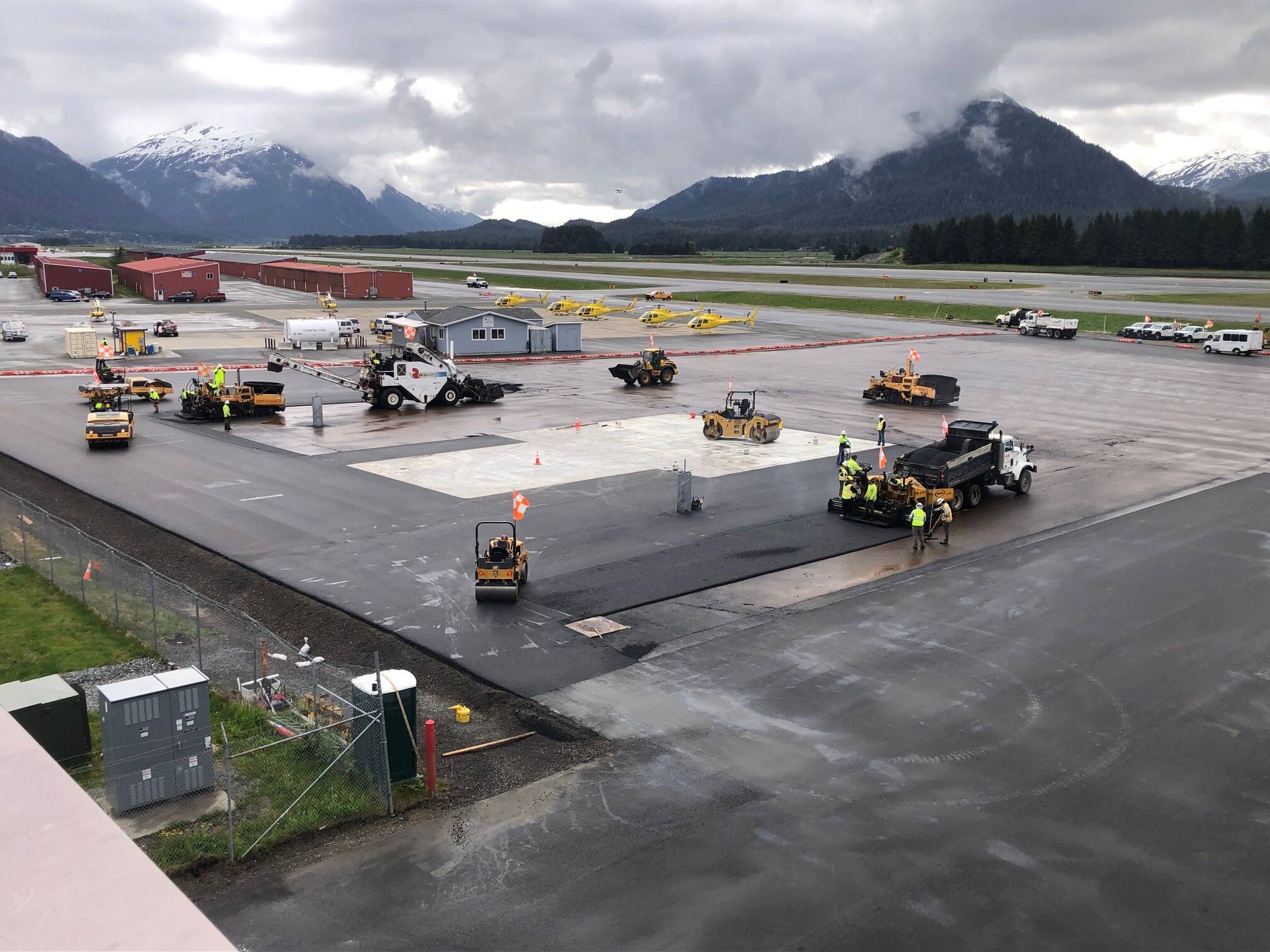A complex repaving project of areas near the terminal at Juneau International Airport is underway using an onsite asphalt batch plant to increase efficiency, according to officials.
The temporary batch plant began operating at the east end of the airport soon after the City and Borough of Juneau Planning Commission approved the operating permit at its Tuesday, May 14 meeting.
“The plant will operate during the construction season of April through October for the next two to three years,” said Airport Manager Patty Wahto in a May 17 phone interview.
“Locating the facility on airport property reduces the traffic on public roads from the large dump trucks hauling asphalt from another site,” she added. The batch plant will serve airport needs solely.
Airport Project Manager Mike Greene is overseeing the paving project which will cover surfaces, or aprons, around the terminal. Runways are not being repaved.
“Asphalt wears out and we have to replace it,” he said on Friday about the paving work being done.
A key new section is being added for large aircraft to park overnight. Heavy planes cannot rest on asphalt for very long periods because their weight is normally concentrated on only three points of contact.
“Asphalt is soft and a plane can sink a bit into the asphalt,” Greene said, which is why there is a “hard stand” area of concrete atop several inches of asphalt for bigger aircraft to “remain overnight,” a term coded as RON.
Having the asphalt batch plant on airport property has an advantage in addition to reducing truck traffic on local highways. The fresh asphalt allows a “hot joint” to fuse side-by-side pavement strips which provides a better seal between sections. Cold joints, caused by farther transport of hot asphalt from a batch plant, shortens the life of the paved junctions.
The plume of dust and heat rising into the air attracted commuters’ curiosity in mid-May when the plant cranked up its fiery operations of heating gravel and tar to bond as asphalt. Drivers have noticed large gravel piles accumulating at the east end of the airport near TEMSCO’s helicopter hangar. When operating, the plant feeds gravel by conveyor belt into a hot rotating cylinder where heated tar mixes to form asphalt that will be carried a short distance by dump truck to be lifted into paving machines that lay and compact the hot surface. Heavy rollers further compact the asphalt. Several layers are necessary to build solid support for large aircraft.
To minimize the impacts on busy airport functions the paving work will be performed in discreet sections. Color-coded illustrations of the various enumerated phases of paving are available on the airport’s website at www.juneau.org/airport. Check the monthly Project Manager’s reports for details.
An important deadline to have certain paving completed is June 7 when Delta Airlines’ first jet of the summer arrives.
Weather can impact the project. Days of heavy rain delay or postpone some paving when accumulated pools of water prevent proper bonding of asphalt layers. Conversely, when fair weather prevails work increases. Crews put in two back-to-back 17-hour days on Tuesday and Wednesday before heavy rain fell on Thursday, slowing progress.
Additional improvements to the airport exterior are planned for summer 2024. Some passenger boarding bridges — also known as “jetways” — that provide passenger loading and unloading will be replaced. Embarkation and debarkation will shift slightly to other nearby areas.
“The airport will stay fully operational during paving and construction,” said Ke Mell, the airport’s architect. She said finishing touches are still being completed inside the renovated terminal as well. Some glass panels are being installed behind temporary sheets of protective plastic suspended from the ceiling. She pointed to the new seating in the secure area departure lounge which can accommodate almost all the passengers from four jets simultaneously if needed. Gone are historic item display cases and circular seating arrangements that reduced space for seating.
Other paving projects around the city planned for this summer will likely rely on the Lemon Creek asphalt plant. Douglas Highway and 10th Street in Juneau are scheduled for renewed road surfacing.
• Contact Laurie Craig at laurie.craig@juneauempire.com.

